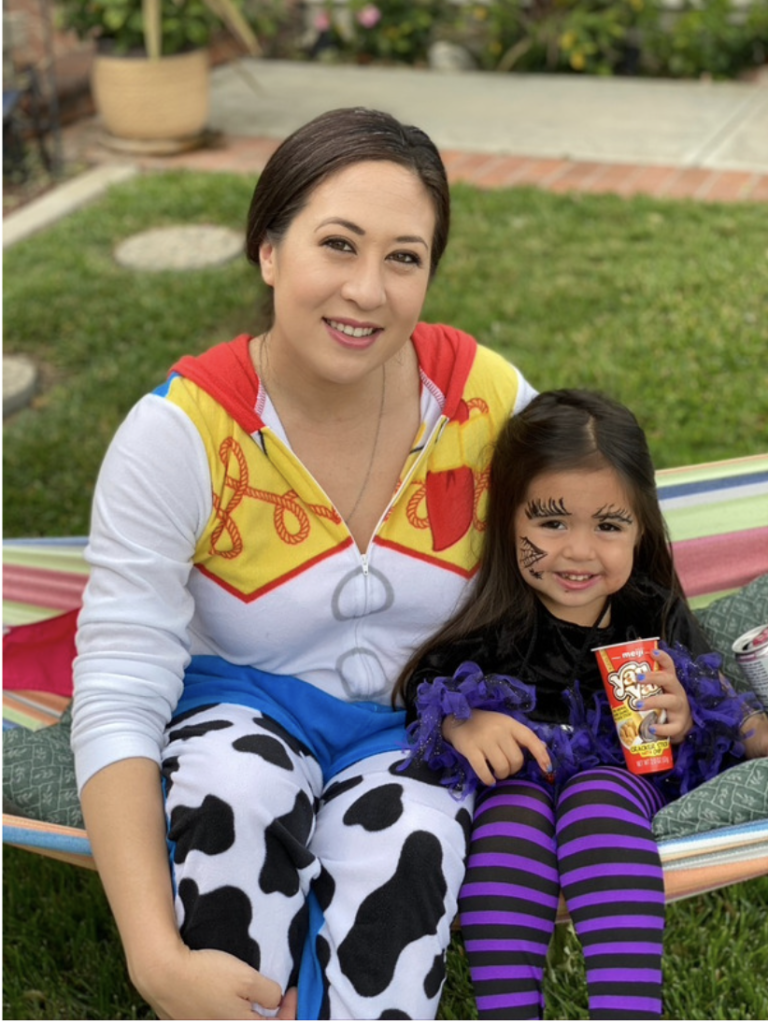Get your FREE sensory profiles cheat sheet >>click here<<
How to prepare your SPD child for Halloween
I can’t even believe it’s already Halloween. First of all, it’s been Halloween year-round in our house. My daughter is literally obsessed with Halloween, we never put away our Halloween toys or plates or books from last year, she just loves villains and witches and all that. But secondly… just… time! I can’t believe it’s already Halloween.
I remember last year, I was worried about how Halloween would feel different in a pandemic, but I remember walking away from it thinking how much better it was with social distancing (particularly for my anxious sensory sensitive child).
Most houses did like a table or candy at the end of their driveway and there was very limited “pressure” to knock on doors or actually talk to people because of this setup. It made for a super smooth trick or treating session and I’m so curious how this year will go if families will do the same modifications.
Today I want to give you some quick tips for setting your sensory child up for success on Halloween.
I’ll share with you some general mindset/expectation tips, tips on preparing for the actual Halloween trick or treating event and then tips for the actual day/time of trick or treating.
THINGS TO KEEP IN MIND ABOUT HALLOWEEN WITH AN SPD KID
First, it’s really important for me to preface this entire episode by giving you this friendly reminder, as a sensory parent myself, I’m no stranger to it… and that’s the fact that holidays come with a lot of excitement and routine changes that can often set the “perfect storm” for meltdowns and general dysregulation. So, I guess what I’m trying to say is….
Manage your own expectations.
I’m always realistic (although if my husband were here, he’d nudge me saying that I’m more pessimistic) in how I expect my child to do with an activity or an event.
For things like Halloween, I find it most helpful for myself if I just go into it knowing that there is a huge chance that she will have some sort of meltdown, or big emotions and that it’s okay and part of the whole “deal”.
If she does well, I’m pleasantly surprised- but I’m always the kind of person that just knows “okay this comes with the territory”.
The thing about Halloween is- there’s a lot of things that are “out of the ordinary” on that day or the following days.
There’s parties, there’s extra candy or other treats, maybe a later bed time, maybe a skipped nap time, maybe some school parades…. A lot of things that can be overwhelming for a sensory child and even though they may enjoy participating in it in the moment… don’t be surprised if you see what I call a little “holiday hangover” the days after.
So for this year, Halloween falls on a Sunday. There’s some pros and cons to that.
One pro is that they won’t be coming from school which has a ton of extra sensory input which can make halloween night even harder. You’ll have the whole day to prepare and have a chill day.
However… this means the next day is a school day and… a Monday which can be hard for a lot of kids, especially sensory kids. This is all impacted by later bedtimes and a sugar rush which can make night time routine even harder on a Sunday.
Download your FREE Halloween Social Story Here!
PREPARING FOR HALLOWEEN WITH AN SPD CHILD
Most of my tips are geared towards children who may have anxieties or sensory sensitivities that would impact Trick or Treating or Halloween events. Maybe you have a child who’s anxious of the dark, or has social anxiety around adults or other kids. Then there’s sensory sensitive children who are sensitive to the sounds/chaos of Halloween night, or sensitive to the fabric of the costumes they wear.
I think particularly if you have a sensitive or anxious young child (2 or 3 years old),this may be their first time that they actually remember trick or treating- especially if they didn’t go last year due to the pandemic. So there’s a lot of unexpected things and the “unknown” is like a huge neon “danger” sign for kids with SPD or anxiety.
The best antidote for dealing with the “unknown” is to make it as “known” as possible.
One of my favorite things to do is to watch youtube videos. Watch youtube videos of kids going trick or treating and talk about what they’re doing- point out their costumes, point out the fact that they’re walking up to doors and knocking on doors. Talk about if it will be sunny or dark when they go trick or treating.
Social stories can be super helpful, too. A social story is like a really short story where your child is the main character and it’s written in the first person.
It usually details a future environment or change or activity they will be going to (like there’s social stories for going to the dentist, or social stories for bringing home a sibling) or there could be social stories written about a behavior or challenge you want them to overcome.
The end of the social story is usually a positive ending and how you would ideally like the scenario to go or end. Throughout the story you explain what your child will be doing/who they come in contact with and, (this is the important part) how they might feel and what they can do if a problem arises.
So you could write a social story about going trick or treating, and I would recommend putting in as many pictures of your child/the neighborhood/other people/costumes that will be involved, etc. Add in as many realistic photos as possible.
It could be as simple as:
“My name is Liliana. For Halloween, I’m going to be a princess (insert picture of them).
When I go trick or treat, I’ll go in my wagon and walk around the neighborhood with my mom and dad and grandma and grandpa (insert picture). I will walk up to the door, knock and say “Trick or Treat”. Some houses might have scary decorations outside. We can skip those houses. If I feel nervous, I can ask my mom for a hug. I don’t have to visit houses I don’t want to.”
Add any details you think you want them to know about, and at the end I’d end it with something like “Halloween will be so much fun.”
Even if you have more of a sensory seeker and you’re worried about how they’ll be in a group of kids or being too rough or running away… you can make a social story about having safe behaviors at Halloween time.
You could read this story everyday until Halloween. You want them to know the story enough that they could almost tell the story to you without reading.
One important aspect to talk to your child about is costumes- talk about the idea that costumes are just playing pretend. Some kids might wear a mask of a scary person or villain from a movie, it does not mean that villain or scary person is there- it’s just a kid in a costume. You would definitely want to role play this with them if they haven’t tried dress up games before.
You could also show them a map of the houses they’ll trick or treat at, or even do a trial run through of the same route you’ll walk during the trick or treating.
Lastly, role-play. It’s like a step up from the social story, but you are actually moving the body/saying the words/ practicing what it will be like to Trick-or-treat.
TIPS FOR HALLOWEEN NIGHT WITH AN SPD CHILD
So on the day of Halloween trick-or treating… I’ll be specific to this year (2021), so it will be a Sunday. This leaves you with the whole day, ideally, to “prep” which actually should just mean “lay low”, especially if you have an over-responsive child who will need to save room in their sensory cup for the big excitement of the day.
Your goal the entire day is to optimize regulation.
Keep meals familiar and safe. This is not the day to try to get them to eat broccoli or eggs if it’s one of their non-safe foods.
Offer lots of heavy work and deep breathing activities throughout the day. Some examples include: building a fort with pillows, doing some animal walks, helping with vacuuming or putting laundry away.

Free: Who Needs Heavy Work?
I mentioned proprioceptive, heavy work in the episode, which is a really calming sensory input. It’s mostly regulating for everyone, but there are some kids who benefit from it more based on their behaviors and needs. This free guides helps you determine if your kid benefits from this particular sensory input.
Now it’s down to the wire… it’s time to go trick or treating, here are some last minute reminders.
First- no matter how much you spent on the costume or how much time you spent sewing it… Don’t be surprised if your child does a last minute “I don’t like this costume” meltdown.

From Stressed to Dressed Guide
If you have a child who has sensitivities to the way that clothes fit, the way that fabrics feel to the point where they won’t wear certain clothes, this guidebook will provide a step-by-step program at home to help add variety to their closet and hopefully decrease your daily clothing battles.
There’s no rules! Don’t be pressured by social media to have a “perfect halloween”! Just stay regulated, that’s your goal!
Try to keep the big picture in mind- it would be so much more meaningful to have your child have a successful and positive night of trick or treating in “regular” clothes vs. in the costume that you bought but not be able to last 2 minutes on the trick or treat route.
If they do have a last minute change of heart- there are some easy alternatives: use makeup to draw something on their face; have them get dressed in pajamas, or put a hat on them.
Bonus- if your child needs to wear noise cancelling headphones you could make that part of their costume- make them a DJ! Actually, noise cancelling headphones is one of my first tips- depending on your neighborhood, some play music outside houses, some kids are extra hyped and loud as you pass by… you may want to bring either noise cancelling headphones or bluetooth headphones that can play calming music or other sounds that may help them feel safe and calm during the trip.
Another tip is to consider trick or treating earlier rather than later- for obvious reasons, dark = more scary and also more late bedtime.
Also- can we not force them to say, “trick or treat”? I know this is more of an issue to take up with those neighbors who insist on your child “performing” for them… but if there’s a way for you to let your child know in advance that they can skip a certain house or they don’t have to say it if they don’t feel like (or if they’re incapable of speaking right now) then maybe you can say it for them at the door.
The next tip- even if your child has surpassed “stroller age”, if you anticipate a long walk, consider bringing a stroller or wagon- this way if they want to take a break from trick or treating but still want to walk around the block with you or the group, they can have a rest. Remember, especially for our sensory sensitive kids, the whole concept of trick or treating is fatiguing in itself… add in some physical movement (in a costume, too) at a time that they’re usually at home- it can catch up to them quickly.
You could even bring fidgets or weighted blankets for the wagon if you want to add extra regulation opportunity.
Here’s a tip for you if you expect transitions (like at the end of the night) will be hard for you when it’s time to go back home. Utilize visual timers like a time timer that shows your child how much time you have left before you turn around or head back to the car/wherever you are for trick or treating.
Another great tip for this is if you print out (or even draw the block you’re walking on, or just make a list of addresses on a page) have your child cross off each house after you finish it. This way they know when they’re approaching the last few or last house.
If you plan to trick or treat with a group, like a group of friends or cousins or neighbors… there can be a lot of “social pressure” with what houses to approach, how long to stay out, etc. It’s helpful if you can help your child (this works more for older school aged children) come up with a “code” or a signal, like an ear tug or a thumbs up that they can use to signal to you that they’re ready to go home or feel nervous or need a hug!
Those are all my tips for a successful night of Trick or Treating. Now, remember, I don’t know who needs to hear this or needs this permission… you do NOT need to take your child trick or treating for them to enjoy halloween. There are SO many other things that you can do to make the night feel just as cool and special.
Build a fort while watching a movie, or you could go on a neighborhood scavenger hunt, still walk around but just “people watch” and look at cool costumes, see how many different costumes you could find.
Links
Transcript/show notes at www.theotbutterfly.com/podcast
Instagram: @TheOTButterfly www.instagram.com/theotbutterfly
Website/blog: www.theotbutterfly.com
Email: LauraPetix@TheOTButterfly.com
Work with me: www.theotbutterfly.com/parentconsult
More SPD parent resources: www.sensorywisesolutions.com
Heavy work blog: www.theotbutterfly.com/heavywork








